Seamanship is the art of operating a ship or boat.
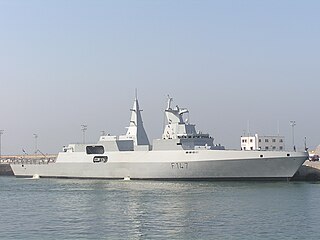
The South African Valour-class frigates are the major surface ships of the South African Navy. Their German manufacturer designates these warships as the MEKO A-200SAN type, member of its MEKO family of naval ships. They were designed and built using principles of stealthy design, including the extensive use of "X-form" structure design in which right angles and vertical surfaces are avoided, and techniques to reduce the infrared signature, such as expelling pre-cooled exhaust gasses just above the waterline. Blohm+Voss, the designers, claim that this class has the radar signature of a vessel one-half her size, 75% less infrared emissions than previous designs, as well as a 20% lower life-cycle cost, 25% lower displacement, and 30% fewer crewmen.

RFA Oakleaf (A111) was a Leaf-class fleet support tanker, formerly of the Royal Fleet Auxiliary, and the second ship to bear the name.
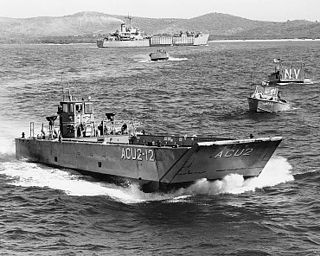
The LCM-8 is a river boat and mechanized landing craft used by the United States Navy and Army during the Vietnam War and subsequent operations. They are currently used by governments and private organizations throughout the world. The acronym stands for "Landing Craft Mechanized, Mark 8".

A pump-jet, hydrojet, or water jet is a marine system that produces a jet of water for propulsion. The mechanical arrangement may be a ducted propeller, a centrifugal pump, or a mixed flow pump which is a combination of both centrifugal and axial designs. The design also incorporates an intake to provide water to the pump and a nozzle to direct the flow of water out of the pump.
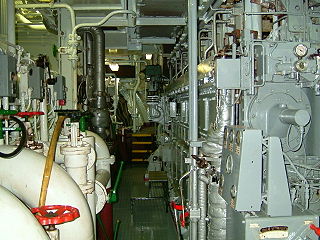
On a ship, the engine room or ER is the propulsion machinery spaces of the vessel. To increase a vessel's safety and chances of surviving damage, the machinery necessary for operations may be segregated into various spaces. The engine room is generally the largest physical compartment of the machinery space. It houses the vessel's prime mover, usually some variations of a heat engine - diesel engine, gas or steam turbine, or some combination of these. On some ships, the machinery space may comprise more than one engine room, such as forward and aft, or port or starboard engine rooms, or may be simply numbered.

Combined diesel and gas(CODAG) is a type of propulsion system for ships that need a maximum speed that is considerably faster than their cruise speed, particularly warships like modern frigates or corvettes.

USS Makin Island (LHD-8), a Wasp-class amphibious assault ship, is the second ship of the United States Navy to be named for Makin Island, target of the Marine Raiders' Makin Island raid early on in the United States' involvement in World War II.

A fireman, stoker or watertender is a person whose occupation it is to tend the fire for the running of a boiler, heating a building, or powering a steam engine. Much of the job is hard physical labor, such as shoveling fuel, typically coal, into the boiler's firebox. On steam locomotives the title fireman is usually used, while on steamships and stationary steam engines, such as those driving saw mills, the title is usually stoker. The German word Heizer is equivalent and in Dutch the word stoker is mostly used too. The United States Navy referred to them as watertenders.

Machinist's mate is a rating in the United States Navy's engineering community.
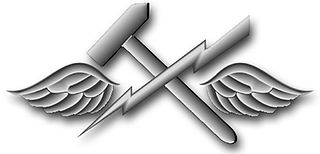
Aviation Support Equipment Technician is a United States Navy occupational rating. The United States Marine Corps currently maintains 3 separate aviation support equipment military occupational specialties. They are: 6071, 6072 aircraft maintenance support equipment hydraulic/ pneumatic structures mechanic and 6073 aircraft maintenance support equipment electrician / refrigeration mechanic.
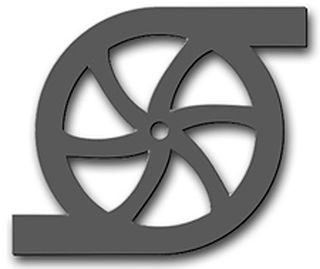
Gas turbine systems technicians is a United States Navy occupational rating.

Machinery repairman is a United States Navy occupational rating.

The Harbour Defence Motor Launch (HDML) was a British small motor vessel of the Second World War.
The U.S. Army Prime Power School is run by the United States Army Corps of Engineers at Fort Leonard Wood, Missouri since January 2011, having previously moved from Fort Belvoir, Virginia. The mission of the school is to produce MOS 12P – Prime Power Production Specialists for the U.S. Army.

USNS Apache (T-ATF-172), fifth United States Navy ship of the name, is the last of the Powhatan class of fleet ocean tugs. Apache was delivered to the U.S. Navy in 1981. She is operated by Military Sealift Command and crewed by 18 civil service mariners (CIVMARS). She is designed to provide the Navy with towing service, and when augmented by Navy divers, assist in the recovery of downed aircraft and ships. There are quarters on board for up to 22 additional personnel.

Luna is a historic tugboat normally berthed in Boston Harbor, Massachusetts. Luna was designed in 1930 by John G. Alden and built by M.M. Davis and Bethlehem Steel. She is listed on the National Register of Historic Places and is a U.S. National Historic Landmark. In 1985, the Luna was designated as a Boston Landmark by the Boston Landmarks Commission.
Machinery Technician (MK) is an enlisted rating in the United States Coast Guard that is responsible for the operation, maintenance and repair of a cutter's propulsion, auxiliary equipment and outside equipment, internal combustion engines, environmental support systems, hydraulics, generator sets, and areas of hazardous material recovery and control. They are also responsible for the engineering maintenance of any small boats assigned to their command. At smaller stations and cutters they also serve as electricians.
















